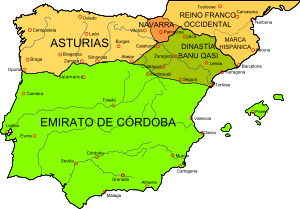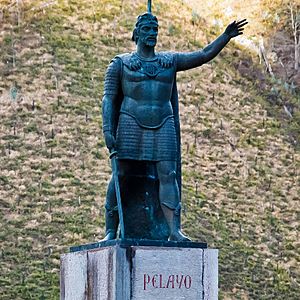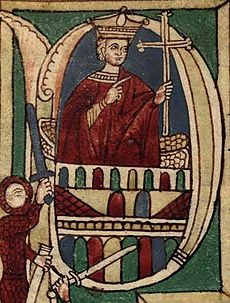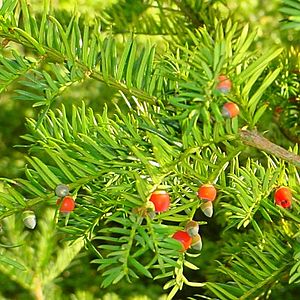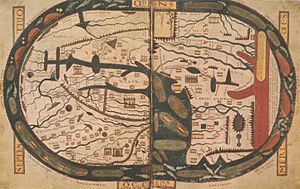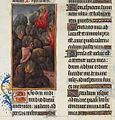Kingdom of Asturias facts for kids
Quick facts for kids
Kingdom of Asturias
|
|||||||||||
|---|---|---|---|---|---|---|---|---|---|---|---|
| 718–924 | |||||||||||
|
Cruz de la Victoria, the jewelled cross as a pre-heraldic symbol
|
|||||||||||
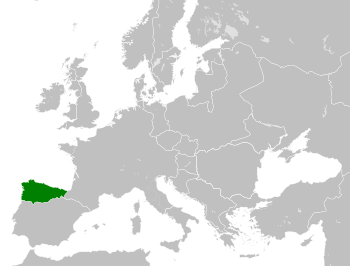
Location of the Kingdom of Asturias in 814 AD
|
|||||||||||
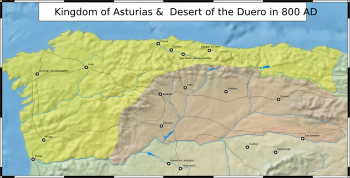
The Kingdom of Asturias circa 800 AD
|
|||||||||||
| Capital | Cangas de Onís, San Martín del Rey Aurelio, Pravia, Oviedo | ||||||||||
| Common languages | Latin, Vulgar Latin (Astur-Leonese, Castilian, Galician-Portuguese), East Germanic varieties (minority speakers of Visigothic and Vandalic) | ||||||||||
| Religion | Christianity (official) | ||||||||||
| Government | Absolute elective monarchy (until 842) Absolute hereditary monarchy (from 842) |
||||||||||
| King | |||||||||||
|
• 718–737
|
Pelagius of Asturias | ||||||||||
|
• 910–925
|
Fruela II of Asturias | ||||||||||
| Historical era | Early Middle Ages | ||||||||||
| 718 | |||||||||||
|
• Monarchy becomes hereditary
|
842 | ||||||||||
|
• Split off of León and Galicia
|
910 | ||||||||||
|
• Disestablished
|
924 | ||||||||||
|
|||||||||||
| Today part of | Spain Portugal |
||||||||||
The Kingdom of Asturias was an important kingdom in the Iberian Peninsula (modern-day Spain and Portugal). It was founded by a brave leader named Pelagius in 718. This kingdom was the first Christian area to be set up after the Muslims took over Visigothic Spain.
Pelagius led a Christian army to victory against the Muslim Umayyad forces at the Battle of Covadonga in 718. This battle is often seen as the start of the Reconquista, which was a long period when Christian kingdoms slowly took back control of the Iberian Peninsula from Muslim rule.
Contents
How the Kingdom Grew Strong
The kings of Asturias sometimes made peace with the Muslims. This happened when they needed to fight other enemies, like the Basques or rebels in Galicia. For example, King Fruela I (757–768) fought both Muslims and other groups. King Silo (774–783) made peace with the Muslims but still had to deal with the Galicians.
King Alfonso II: A Strong Leader
Under King Alfonso II (791–842), the kingdom became much stronger. Important leaders like Charlemagne and the Pope recognized him as the King of Asturias. He expanded the kingdom by conquering Galicia and the Basque lands.
During Alfonso II's rule, something amazing happened: the holy bones of Saint James the Great were said to be found in Galicia, in a place called Compostela. This discovery led to many pilgrims from all over Europe visiting the site. These pilgrims helped connect Asturias, which was quite isolated, with other parts of Europe.
Alfonso II also had a clever plan to protect his kingdom. He encouraged people to move from the south to areas north of the mountains. This helped increase the population and military strength. The kingdom became powerful enough to raid Muslim cities like Lisbon, Zamora, and Coimbra. These raids were mostly for treasure and tribute, not for permanent conquest.
Challenges and Victories
In the summers of 792, 793, and 794, Muslim armies attacked the Asturian kingdom. They plundered areas like Alava and even reached the capital, Oviedo. But during one of their retreats, Alfonso II's army dealt a big defeat to the Muslims in a swampy area called Lutos.
When Alfonso II died, Ramiro I (842–850) became king after a struggle for the throne. Early in his reign, in 844, Ramiro faced a Viking attack near Corunna. He gathered an army and defeated the Vikings, burning many of their ships. In 859, another Viking fleet attacked, but they were also defeated by Count Pedro off the coast of Galicia.
Expanding the Kingdom's Borders
The Kingdom of Asturias grew a lot under King Alfonso III (866–910). This was possible because Muslim control in many parts of Al-Andalus (Muslim Spain) was weakening. The Asturian kingdom expanded its western border into what is now northern Portugal, reaching the Douro valley by 773. Between 868 and 881, it expanded even further south to the Mondego.
In 878, Muslim forces attacked the towns of Astorga and León. One part of their army was badly defeated at Polvoraria on the Órbigo river, with many soldiers lost. In 881, Alfonso III went on the attack. He led his army deep into Muslim territory, crossing the Tagus River and approaching Mérida. His army defeated the Umayyad army on "Monte Oxifer," with many Muslim soldiers reportedly killed. After returning home, Alfonso III focused on building churches in Oviedo and new palaces.
The Kingdom of Asturias eventually changed into the Kingdom of León in 924. This happened when Fruela II of Asturias became king and moved his royal court to León.
The People of Asturias
The Kingdom of Asturias started in the western and central parts of the Cantabrian Mountains. This area includes the Picos de Europa mountains. Ancient Greek and Roman writers described several Celtic groups living in Asturias at the beginning of the Christian era. These groups included the Vadinienses, Orgenomesci, Saelini, Luggones, Astures, and Paesici.
Over time, a unique Asturian identity began to form. The long struggles between the Visigoths and the Suebians may have helped create a distinct identity among the people of the Cantabrian region. Archaeological discoveries at La Carisa show remains of a defensive wall built between 675 and 725 AD. This wall protected central Asturias from invaders coming from the south. Building these defenses shows that the Asturian communities were well-organized and worked together to protect themselves.
This growing Asturian identity led to the creation of the Kingdom of Asturias after Pelagius's victory at Covadonga in the early 8th century.
How the Kingdom Started
The kingdom was founded by the nobleman Pelagius. Before the Muslim conquest, Asturias was taken over by Musa bin Nusayr in 714 without much resistance. Muslim troops often took hostages to ensure peace in newly conquered areas.
After the first Muslim leader, Tarik, reached Toledo in 711, another leader, Musa bin Nusayr, crossed the Strait of Gibraltar and conquered many cities. He reached the northwest of Spain, taking control of Lugo and Gijón. In Gijón, he left a small Berber army under a governor named Munuza to control Asturias. Some nobles, possibly including Pelagius, had to send hostages to Cordoba to show their loyalty.
The most common idea about the Battle of Covadonga is that the Muslim army was attacked from cliffs and then retreated. They were then attacked again and almost completely destroyed. However, the oldest Christian record from that time, the Chronicle of 754, does not mention this battle.
According to other chronicles, Pelagius escaped from Cordoba and returned to Asturias. This started a revolt against the Muslim rulers in Gijón. Pelagius and his followers took refuge in a cave in Covadonga. After a failed siege, the Muslim troops were ambushed and nearly wiped out. This victory, though small, gave Pelagius great respect and led other nobles in Galicia and Asturias to join him, electing him as their leader.
Under Pelagius, attacks on the Berbers increased. Munuza, feeling isolated, decided to leave Gijón but was intercepted and killed by Asturians. Pelagius then attacked León and secured the mountain passes, protecting the region from more Muslim attacks. He also arranged important marriages, like his daughter Ermesinda marrying Alfonso, the son of Peter of Cantabria, another powerful noble.
Archaeological digs have found fortifications in Mount Homon and La Carisa, dating from the late 7th and early 8th centuries. These defenses, with watchtowers and deep moats, would have needed many people to build and defend. This suggests a high level of organization, possibly led by Pelagius, to prevent Muslim forces from re-entering Asturias.
Early Kings and Their Challenges
After Pelagius's victory, a small independent area was created in the Asturian mountains, which became the Kingdom of Asturias. The first kings of Asturias called themselves "princeps" (prince) and later "rex" (king). The title of "princeps" was used by local peoples in Northern Spain who had resisted both the Romans and the Visigoths. They didn't want to be ruled by the Muslim Caliphate. People fleeing from Muslim Spain brought Gothic influences to the Asturian kingdom.
In the early years, the Asturian kings strengthened their control by arranging marriages with other powerful families in Northern Spain. For example, Pelagius's daughter, Ermesinda, married Alfonso, the son of Duke Peter of Cantabria.
After Pelagius died in 737, his son Favila was elected king. The chronicles say Favila was killed by a bear while hunting. After his death, the rule of Asturias passed to his brother-in-law, Alfonso I, through his marriage to Favila's sister. This shows that women's family ties and inheritance rights were still important.
Pelagius started a royal family in Asturias that lasted for decades. They slowly expanded the kingdom's borders until all of northwest Spain was included by around 775. The reign of Alfonso II (791–842) saw the kingdom expand even further south, almost reaching Lisbon.
How the Kingdom Grew
Favila was followed by Alfonso I, who became king because he married Pelagius's daughter, Ermesinda. Alfonso I began expanding the small Christian kingdom from its starting point in the Picos de Europa. He moved west into Galicia and south into the Douro valley. He took cities and towns, moving their people to safer areas in the north. This created a mostly empty area in the south, which acted as a shield against Muslim attacks.
The idea that the south was completely empty is now debated by historians. It's more likely that there was a shift towards rural life, with people living in small farming communities. This happened because the Roman economic system collapsed, there were many epidemics, and Berber soldiers left Muslim Spain after a revolt. All these factors created a less populated area that protected the Asturian kingdom and allowed it to grow stronger.
The campaigns of kings Alfonso I and Fruela in the Duero valley were probably similar to raids that the Astures made in pre-Roman times. The first Asturian expansion mainly covered the Cantabrian region. It wasn't until the reigns of Ordoño I and Alfonso III that the Kingdom of Asturias truly controlled the lands south of the Cantabrian Mountains.
Fruela I, Alfonso I's son, made his father's kingdom stronger and larger. He was later killed by nobles linked to the House of Cantabria.
Changes in Society and Politics
The reigns of Aurelio, Silo, Mauregatus, and Bermudo I are not well-documented. This period (768–791) was once seen as a time when the kingdom was weak because there were no major military actions against Muslim Spain. However, important changes were happening inside the kingdom that helped it become stronger and expand later.
First, the first internal rebellion, led by Mauregato (783–788), happened during these years. This rebellion removed Alfonso II from the throne (though he later became king again). This started a series of rebellions by rising noble families and landowners. They wanted more power because the region's economy was growing.
Second, rebellions by the Basques and Galicians were put down by Asturian kings. These groups sometimes helped those fighting for the Asturian throne.
Finally, other signs show big changes were happening. Rebellions by freed slaves happened during Aurelio I's reign. This, along with a growing focus on individual families rather than large extended families, shows that a new society was forming in Asturias in the late 8th and early 9th centuries.
Fruela I (757–768) was followed by Aurelius (768–774), who moved the court to what is now San Martín del Rey Aurelio. Silo (774–783) succeeded Aurelio and moved the court to Pravia. Silo was married to Adosinda, Alfonso I's daughter.
Alfonso II was chosen king after Silo's death. But Mauregato strongly opposed him and forced Alfonso to retreat. Mauregato then took the Asturian throne. Despite a bad reputation, Mauregato had good relations with Beatus of Liébana, an important cultural figure, and supported him in his fight against a religious idea called adoptionism. Mauregato was followed by Bermudo I, Aurelio's brother. Bermudo I gave up his throne after a military defeat and lived the rest of his life in a monastery.
A Stronger Kingdom
It wasn't until King Alfonso II (791–842) that the kingdom became truly stable. He made ties with the Franks (a powerful kingdom in Europe), even sending gifts to Charlemagne. Alfonso II saw himself as "an Emperor Charlemagne's man," suggesting a close relationship. During his reign, Alfonso II tried to bring back the order and ceremonies of the old Visigothic Kingdom to his court.
Around this time, the holy bones of Saint James were said to be found in Galicia. A contemporary pope in Rome confirmed them as real. However, during the Asturian period, the resting place of Eulalia of Mérida in Oviedo was the main religious site.
Alfonso II also helped repopulate parts of Galicia, León, and Castile, bringing them into the Kingdom of Asturias. He also gained influence over parts of the Basque lands. The first capital was Cangas de Onís, then Pravia, and finally Alfonso II chose his birthplace, Oviedo, as the capital around 789.
Ramiro I started his reign by capturing and blinding other people who wanted the throne, sending them to monasteries. As a warrior, he defeated a Viking invasion and fought several battles against the Muslims.
When he followed his father Ramiro, Ordoño I (850–866) put down a big revolt among the Basques. In 859, Ordoño attacked the fortress of Albelda, which was built by Musa ibn Musa, a Muslim leader who had rebelled against Cordoba. Musa tried to break the siege with the help of his brother-in-law, the king of Pamplona. But Musa was defeated and lost valuable treasures, some of which were sent as a gift to Charles the Bald of Francia. Albelda fell, and its warriors were killed. Musa was wounded and died later.
When Alfonso III's sons forced him to give up his throne in 910, the Kingdom of Asturias split into three separate kingdoms: León, Galicia, and Asturias. These three kingdoms were eventually reunited in 924 under the crown of León. The kingdom continued under the name of León until it became part of the Kingdom of Castile in 1230.
Viking Attacks
The Vikings attacked Galicia in 844 but were strongly defeated by Ramiro I at Corunna. Many Vikings were killed by the Galicians' powerful weapons called ballistas, which were like giant crossbows. Seventy Viking ships were captured and burned. A few months later, another Viking fleet attacked Seville.
Vikings returned to Galicia in 859 during the reign of Ordoño I. Ordoño was busy fighting the Muslims, but a local count, Don Pedro, attacked the Vikings and defeated them, causing heavy losses. Ordoño's successor, Alfonso III, worked to protect the coast from Viking and Muslim attacks. In 968, a Viking leader named Gunrod attacked Galicia with 100 ships and 8,000 warriors. They roamed freely for years and even took over Santiago de Compostela. A Galician count, Gonzalo Sánchez, ended the Viking adventure in 971. He launched a powerful attack, defeated the Vikings in a bloody battle, and captured Gunrod, who was then executed.
Religion and Beliefs
Old Traditions and Christianity
Even though the first signs of Christian worship in Asturias are from the 5th century, Christianity didn't spread much until the mid-6th century. During this time, hermits and monks started settling in the Cantabrian mountains and teaching Christian ideas.
Christianity spread slowly in Asturias and didn't completely replace older pagan gods. Like in other parts of Europe, the new religion mixed with old beliefs. For example, in the 6th century, a bishop complained that Galician farmers still worshipped pre-Christian gods.
In the Sella valley, near Cangas de Onís, there was an ancient burial site called a dolmen, built thousands of years ago. Leaders from the area were buried there. These practices continued even after the Roman and Visigothic conquests. King Favila was buried there in the 8th century. Although the Asturian monarchy promoted Christianity at this site by building a church, some pagan traditions linked to the Santa Cruz dolmen still exist today. People say that xanas (Asturian fairies) appear there, and the soil is believed to have magical properties.
An inscription in the Santa Cruz church says it was dedicated in 738 and led by a vates named Asterio. The word vates is unusual for a Christian priest; it usually means a poet who can see the future, or a Celtic priest. Some historians think Asterio might have combined pagan and Christian religious roles.
Asturian kings promoted Christianity and based their power on Christian writings, not on local religious traditions. They used the Visigothic Code as their law. New ideas also came from people fleeing Muslim Spain and from Charlemagne's Frankish Kingdom.
The Adoptionism Debate
The foundations of Asturian culture were laid during the reigns of Silo and Mauregatus. A very important Christian scholar of this time was Beatus of Liébana. His works greatly influenced Christian culture during the Reconquista.
Beatus was involved in a big debate about a belief called adoptionism. This idea claimed that Jesus was born a man and only became divine after his death and resurrection. Beatus strongly disagreed with this, arguing against figures like Elipando, the bishop of Toledo.
Adoptionism had roots in Gothic Arianism, which denied Jesus's full divinity, and in Greek ideas about heroes becoming gods. Also, since Toledo was under Muslim rule, Islamic beliefs (which see Jesus as a prophet, not God's son) might have influenced adoptionism. Beatus fought against adoptionism from his abbey. He also strengthened ties between Asturias, the Holy See (the Pope), and the Carolingian Empire, getting support from the Pope and his friend Alcuin of York.
Prophecies and Symbols
Beatus's most famous works were his Commentaries on the Apocalypse. These were copied into beautiful manuscripts called beati, known for their amazing illustrations. In these commentaries, Beatus gave a new meaning to the apocalyptic stories. He said that Babylon now represented Cordoba, the capital of Muslim Spain. The Beast, once a symbol of the Roman Empire, now stood for the Muslim invaders who threatened to destroy Western Christianity and raided the Asturian Kingdom.
The prologue to the second book of the Commentaries includes the Beatus map, one of the best maps from the early Middle Ages. This map wasn't meant to be perfectly accurate. Its purpose was to show how the Apostles spread Christianity around the world.
Beatus believed that the Apocalypse described in the Bible was coming soon. He thought it would be followed by 1290 years of rule by the Antichrist. Beatus followed the ideas of Augustine of Hippo, who believed world history was divided into six ages. The sixth age, after Christ, would end with the events of the Apocalypse.
Many people in Europe at that time believed the end of the world was near. Beatus even told his countrymen that the End of Time would come on Easter in the year 800. Hundreds of peasants gathered, waiting in fear. They waited for a day and a half without eating until one of them said, "Let's eat and drink, so that if the End of the World comes we are full!"
Beatus's prophecies had a lasting impact on the Kingdom of Asturias. The Chronica Prophetica, written around 880 CE, predicted the fall of Muslim Cordoba and the conquest of all of Spain by King Alfonso III. This idea of a coming victory is also seen in the Victory Cross icon, a main symbol of the Asturian kingdom. This cross is often found in old Asturian churches with the saying: "Hoc signo tuetur pius, in hoc signo vincitur inimicus" (By this sign the pious is protected, by this sign the enemy is conquered). This became the motto of the Asturian kings.
The Camino de Santiago
Another important legacy of the Asturian kingdom is the creation of the Camino de Santiago (Way of St. James). This became one of the most important cultural routes in Europe. The first text mentioning St. James preaching in Spain is from the 6th century. Later, in the time of Mauregato, a hymn called O Dei Verbum called St. James "the golden head of Spain, our protector and national patron."
The legend of St. James became very popular during the reign of Alfonso II. A hermit named Pelagius claimed to see a mysterious light over a forest in Galicia for several nights. Angelic songs accompanied the lights. Impressed, Pelagius told the bishop, Theodemir, who visited the site. Legend says they found a stone tomb with three bodies, identified as Saint James and his two disciples. King Alfonso was said to be the first pilgrim to visit the Apostle's tomb. He was guided by the Milky Way, which then became known as the Camino de Santiago.
The discovery of St. James's tomb was a huge success for the Kingdom of Asturias. Now, Asturias could claim to have the body of one of Jesus's apostles, a privilege shared only with Ephesus (where John the Apostle was buried) and Rome (where Saint Peter and Saint Paul rested). By the early 12th century, Santiago de Compostela became one of the three most sacred cities in Christianity, along with Rome and Jerusalem. Over the centuries, many cultural influences from Central Europe traveled to Spain through the Way of St. James.
However, some parts of the "discovery" story are mysterious. The tomb was found in an area used as a burial ground since Roman times, so the body might have belonged to another important person. Some historians suggest the tomb might hold the remains of Priscillian, a religious leader. Others point out that several places in Galicia were already pagan pilgrimage sites before the discovery of St. James's tomb. After the discovery, these routes slowly became Christian pilgrimage routes.
Asturian Myths and Legends
Since the chronicles of the Asturian kingdom were written long after the Battle of Covadonga, many stories about the first Asturian kings are mixed with myths and legends.
While Pelagius was a real person, the stories about him include many folktales. One says that before the Muslim invasion, Pelagius went on a pilgrimage to Jerusalem. However, there's no proof of this.
It's also said that the Cruz de la Victoria (Victory Cross) was first carved into an oak log by a lightning strike. This story has two important elements from Asturian folklore. Lightning was an old symbol of the Astur god Taranis, and in Asturian mythology, it was believed to be made by the Nuberu, the lord of clouds, rain, and wind. The oak tree is a symbol of Asturian royalty, and oak leaves are shown in carvings at the Abamia Church, where Pelagius was buried.
The Covadonga area is full of amazing stories. One tells of a shepherd village where the Lakes Enol and Ercina are now. Mary, mother of Jesus, disguised as a pilgrim, visited the village and asked for food and shelter. Everyone refused her except for one shepherd who kindly shared everything he had. The next day, as punishment for their lack of kindness, a divine flood destroyed the village, covering everything except the good shepherd's cottage. Mary then cried, and her tears turned into flowers when they touched the ground. The shepherd then realized she was Mary.
There are also myths about the Asturian monarchy that come from Jewish and Christian traditions. The Chronica ad Sebastianum tells of an amazing event when Alfonso I died. While nobles were mourning him, they heard angels singing from the sky. This song was from Hezekiah, a king from the Old Testament.
Asturias also has examples of the king in the mountain myth. Tradition says that King Fruela can still be seen walking around the Jardín de los Reyes Caudillos (a part of the Oviedo Cathedral). It's also said that his grandson, the famous knight Bernardo del Carpio, sleeps in a cave in the Asturian mountains. The story goes that a peasant once went into a cave to find his lost cow and heard a strong voice. The voice said it was Bernardo del Carpio, who had defeated the Franks at Roncevaux. Bernardo asked the peasant for his hand to see how strong people were today. The scared shepherd gave him the horn of his cow, which the giant man immediately broke. The peasant ran away terrified, hearing Bernardo say, "Current men are not like those who helped me kill Frenchmen in Roncevaux."
Images for kids
-
Ercina lake, Covadonga. According to the legend, under its waters a village—or perhaps a city—is hidden.
-
Illustration of Hezekiah's Canticle belonging to the Très Riches Heures du Duc de Berry. The Asturian monarchs often took the kings of the Old Testament as their models.
Lasting Impact of Asturias
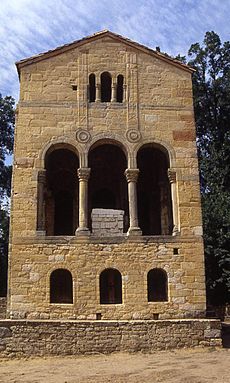
The Kingdom of Asturias began as a local response by the Astures and Cantabri people to an invasion. These people had fought the Romans before and at first resisted Roman culture. Even though they kept many parts of their old culture, their Celtic languages were later replaced by Latin.
This kingdom is where an important European medieval architectural style was born: Asturian pre-Romanesque. This unique style of building started during the reign of Ramiro I.
This small kingdom was also key in fighting against the adoptionist heresy, with Beatus of Liébana being a major figure. In the time of Alfonso II, the shrine of Santiago de Compostela was "found." The pilgrimage to Santiago, known as the Camino de Santiago, became a major connection point in Europe. Many pilgrims (and their money) traveled through Asturias on their way to Santiago de Compostela.
See Also
 In Spanish: Reino de Asturias para niños
In Spanish: Reino de Asturias para niños
- Asturian art
- Autonomous community of Asturias.
- List of Asturian monarchs
- Monarchs' family tree
- Reconquista
- Timeline of the Muslim occupation of the Iberian Peninsula



